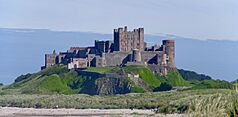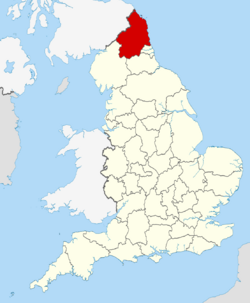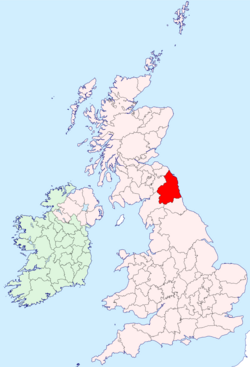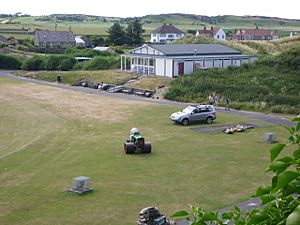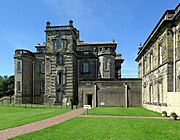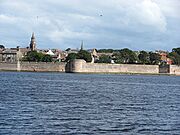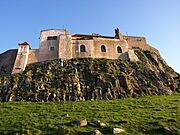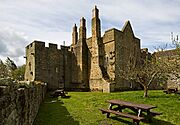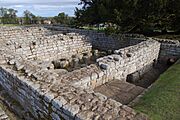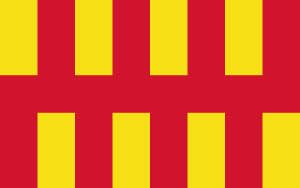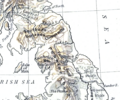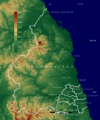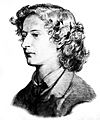Northumberland facts for kids
Quick facts for kids
Northumberland
|
|||||||||||||||||||||||||||||||||||||||||||||||
|---|---|---|---|---|---|---|---|---|---|---|---|---|---|---|---|---|---|---|---|---|---|---|---|---|---|---|---|---|---|---|---|---|---|---|---|---|---|---|---|---|---|---|---|---|---|---|---|
|
|
|||||||||||||||||||||||||||||||||||||||||||||||
| Sovereign state | United Kingdom | ||||||||||||||||||||||||||||||||||||||||||||||
| Constituent country | England | ||||||||||||||||||||||||||||||||||||||||||||||
| Region | North East | ||||||||||||||||||||||||||||||||||||||||||||||
| Established | Ancient 12th century |
||||||||||||||||||||||||||||||||||||||||||||||
| Time zone | UTC±00:00 (Greenwich Mean Time) | ||||||||||||||||||||||||||||||||||||||||||||||
| • Summer (DST) | UTC+01:00 (British Summer Time) | ||||||||||||||||||||||||||||||||||||||||||||||
| Members of Parliament | List of MPs | ||||||||||||||||||||||||||||||||||||||||||||||
| Police | Northumbria Police | ||||||||||||||||||||||||||||||||||||||||||||||
| Largest town | Blyth | ||||||||||||||||||||||||||||||||||||||||||||||
|
|||||||||||||||||||||||||||||||||||||||||||||||
Northumberland is a county in the North East of England. It shares a border with Scotland to the north. To the east, it meets the North Sea, and to the south, it borders Tyne and Wear and County Durham. To the west, you'll find Cumbria. The biggest town in Northumberland is Blyth.
Northumberland covers about 5,013 square kilometers (1,936 square miles). It has a population of around 320,274 people. This makes it the least crowded county in England. The south-east part of the county has the largest towns. These include Blyth (with about 37,339 people), Cramlington (27,683), Ashington (27,670), and Morpeth (14,304). Morpeth is also the main administrative center. Most of the county is countryside. The largest towns in the rural areas are Berwick-upon-Tweed (12,043) in the far north and Hexham (13,097) in the west.
The western part of Northumberland has hills like the Cheviot Hills and North Pennines. As you move east, the land becomes flatter towards the coast. The Cheviot mountain, which is 815 meters (2,674 feet) tall, is the highest point in the county. Many rivers flow through Northumberland. The Blyth, Coquet, Aln, Wansbeck, and Tweed are some of the main ones. The Tweed even forms part of the border with Scotland. The county is home to Northumberland National Park and two special natural areas: the Northumberland Coast and part of the North Pennines.
Northumberland's history is shaped by its location on a border. In Roman times, much of the county was north of Hadrian's Wall. Later, it was often fought over by England and Scotland. This led to many castles and towers being built. Lindisfarne, a tidal island, is also important for its connection to Celtic Christianity. During the Industrial Revolution, Northumberland was known for coal mining, shipbuilding, and making weapons.
Contents
Discovering Northumberland's Past
Where Did the Name Come From?
The name Northumberland comes from an old English phrase, norð hẏmbra land. This means "the land north of the Humber River". The old kingdom of Northumbria got its name from "the people or area north of the Humber". This was different from "Southumbria," which was south of the Humber.
Ancient Times and Roman Rule
This land has always been a border area, now next to Scotland. Northumberland has a very old history with lots of rock art, hillforts like Yeavering Bell, and stone circles such as the Goatstones. Long ago, the Votadini people lived here, and the Brigantes tribe was to the south.
During the Roman period, most of what is now Northumberland was north of Hadrian's Wall. The Romans only controlled it for a short time when they expanded their power north to the Antonine Wall. The Roman road called Dere Street crosses the county. Because it was a border area in medieval times, Northumberland has more castles than any other English county. These include Alnwick, Bamburgh, and Warkworth.
In 2017, experts found nearly 2,000-year-old Roman boxing gloves at Vindolanda. These leather gloves, from around 120 AD, look like modern boxing gloves. They were likely used for training, not deadly fights. You can see them at Vindolanda's museum.
The Kingdom of Northumbria
Northumberland was the heart of the Anglian kingdom of Bernicia from about 547 AD. It later joined with Deira to form the kingdom of Northumbria in the 7th century. This large kingdom stretched from the Humber River in the south to the Forth in the north. Northumberland is often called the "cradle of Christianity" in England. This is because Christianity grew strong on Lindisfarne (also known as Holy Island). This happened after King Oswald of Northumbria invited monks from Iona to teach the English about Christianity. The Lindisfarne Gospels were created at the Lindisfarne monastery around 700 AD. St Cuthbert lived there and is now buried in Durham Cathedral.
After the Vikings invaded, the Kingdom of Northumbria broke into smaller parts. In the south, Vikings created the Kingdom of York. North of the River Tyne, the Earls of Bamburgh continued to rule. After a battle in 1018, the northern part of Northumbria, including Lothian, became part of Scotland.
Northumberland as a County
For a short time, Scottish royalty held the Earldom of Northumberland through marriage. Scotland gave up all claims to the area in 1237. The Earls of Northumberland were very powerful. They were like military leaders who protected England from Scottish attacks.
Northumberland has a history of revolts against the government. The Rising of the North (1569–1570) against Elizabeth I is an example. These revolts were often led by the Percy family, the Earls of Northumberland. Shakespeare even wrote about one of them, Harry Hotspur. After England and Scotland joined under King James I and VI in 1603, the border conflicts mostly stopped.
Northumberland was very important during the Industrial Revolution from the 18th century. Many coal mines operated here until the 1970s and 1980s. The coal from these mines helped power industries across Britain. The need to move coal led to the development of the first railways. Shipbuilding and making weapons were also big industries before they declined in the 1980s.
Today, Northumberland is still mostly rural. It is the least crowded county in England. In recent years, tourism has grown a lot. People visit for its beautiful scenery and historical places.
Exploring Northumberland's Geography
Northumberland has many different types of land. It is low and flat near the North Sea coast. Towards the northwest, it becomes more mountainous. Being in the far north of England, Northumberland is one of the coldest areas. However, because it's on the east coast, it doesn't get a lot of rain. The most rain falls on the high lands in the west.
About a quarter of the county is part of the Northumberland National Park. This area has amazing landscapes and is protected from too much building or farming. The park stretches from the Scottish border south and includes Hadrian's Wall. Most of the park is over 240 meters (787 feet) above sea level. The Northumberland Coast is also a special area known for its natural beauty. A small part of the North Pennines is also in the county.
Northumberland has many nature reserves. These include Holy Island National Nature Reserve and Farne Islands National Nature Reserve. Did you know that 50% of England's red squirrel population lives in the Kielder Water and Forest Park?
Understanding Northumberland's Geology
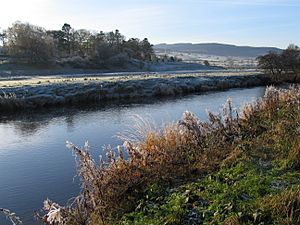
The Cheviot Hills in the northwest are made mostly of strong granite and lava rock. Another area of hard rock is under the Whin Sill, where Hadrian's Wall runs. Both these rocky areas have a bare, open landscape. On either side of the Whin Sill, the county sits on Carboniferous Limestone, which creates some unique landforms. The Farne Islands off the coast are also made of this hard rock and are famous for their birds.
The Northumberland Coalfield stretches across the southeast of the county. Coal was mined here for a long time. The term 'sea coal' might have come from pieces of coal found on beaches, broken off from rocks by waves.
Green Spaces and Protection
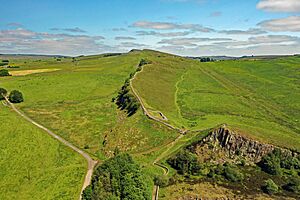
Northumberland has a "green belt" in the south. This area surrounds towns like Cramlington and other communities near the county border. It helps protect them from the larger Tyneside urban area. This green belt continues west along the border, past Darras Hall, and towards Hexham. There are also separate green belt areas, like east of Morpeth. The green belt was first created in the 1950s.
People and Population
In the 2011 UK Census, Northumberland had a population of 316,028 people. Northumberland is mostly rural with large areas of high land. This means it has a low population density, with only about 62 people per square kilometer. This makes it the least crowded county in England.
Economy and Industries
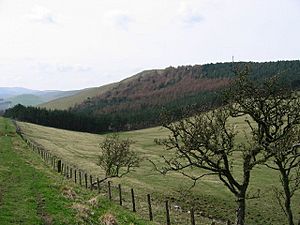
Some big international companies have facilities in Northumberland, such as Coca-Cola and MSD.
Tourism is a very important part of Northumberland's economy. Many people visit the county, which creates jobs and brings in money. In the early 2000s, Northumberland welcomed over a million British visitors and 50,000 foreign tourists each year. They spent a total of £162 million.
Coal mining has been happening in the county since the Tudor times. Even today, some coal mines are still active, many of them are open-cast mines.
A big employer in Northumberland is Hexham-based Egger (UK) Limited.
Local Media
Northumberland doesn't have very large cities, so its main news and entertainment often come from nearby Tyne and Wear. This includes radio stations like BBC Radio Newcastle and TV channels like BBC Look North. However, Northumberland also has its own local newspapers. These include the Northumberland Gazette, Morpeth Herald, and Berwick Advertiser.
Lionheart Radio, a local radio station in Alnwick, has a special license to broadcast to the community.
Local Businesses
Many well-known products are made in Northumberland. For example, Hammerite and Cuprinol paints are made in Prudhoe. A Procter & Gamble factory in Seaton Delaval makes Hugo Boss aftershave and Clairol hair dye. McQuay UK makes air conditioning systems in Cramlington. Coca-Cola makes its Abbey Well mineral water in Morpeth. The National Renewable Energy Centre (Narec) is located in Blyth.
Towns and Villages
Northumberland has many towns and villages, each with its own history and community. Here are some of the parishes and their populations from 2001:
| Name | Population (2001) |
|---|---|
| Acklington | 467 |
| Acomb | 1,184 |
| Allendale | 2,120 |
| Alnwick | 7,767 |
| Amble | 6,044 |
| Bamburgh | 454 |
| Belford | 1,055 |
| Bedlington | 18,470 |
| East Chevington | 3,192 |
| Ellington and Linton | 2,678 |
| Hexham | 11,829 |
| Holy Island | 162 |
| Longframlington | 979 |
| Longhoughton | 1,442 |
| Lynemouth | 1,832 |
| Morpeth | 13,833 |
| Norham | 536 |
| North Sunderland | 1,803 |
| Pegswood | 3,174 |
| Ponteland | 10,871 |
| Prudhoe | 11,500 |
| Rothbury | 1,740 |
| Shilbottle | 1,349 |
| Stamfordham | 1,047 |
| Stannington | 1,219 |
| Warkworth | 1,493 |
| Widdrington Station and Stobswood | 2,386 |
| Wooler | 1,857 |
The population of Cramlington is estimated at 39,000.
Historic Areas
Some places that were historically part of Northumberland are now in Tyne and Wear. These include:
Sports and Activities
Football Fun
An old version of football is still played in some annual games at Alnwick on Shrove Tuesday. Records from 1280 show that a man was killed playing football near Morpeth. Modern football teams started appearing in the 1870s. Newcastle United Football Club was formed in 1892.
Newcastle United won the top division three times in the early 1900s. They also won the FA Cup in 1910. Today, Newcastle United is a Premier League team. Their home ground, St James' Park in Newcastle, is a top football venue. It often hosts international games. Blyth Spartans A.F.C. has also gained attention for their runs in the Football Association Cup.
Famous Footballers from Northumberland
Many famous footballers come from Northumberland. Before and after World War II, greats like George Camsell and Hughie Gallacher played. Joe Harvey, Jackie Milburn, and Brian Clough were also notable players. Bobby Moncur led Newcastle to win the Inter City Fairs Cup in 1969.
Two of Jackie Milburn's nephews, Bobby Charlton and Jackie Charlton, are perhaps the most important players for England. They both played key roles in Alf Ramsey's 1966 England World Cup winning team. Later players like Malcolm Macdonald, Peter Beardsley, Paul Gascoigne, Chris Waddle, and Alan Shearer also became famous. Shearer is still the highest-scoring player in Premier League history!
Horse Racing
Early horse races were held at Newcastle's Killingworth Moor from 1632. The 'Pitmen's Derby' or Northumberland Plate started in 1833. Today, horse racing still happens at Newcastle Racecourse.
Golfing Greens
Golf is thought to have been played in this region by St Cuthbert on the Northumberland coast dunes. The oldest golf club in Northumberland is at Alnmouth, founded in 1869. It is the fourth oldest in the country and is now the Alnmouth Village Club.
There is an old links course at Goswick. It's a classic Northumberland links course, so much so that the Royal and Ancient Golf Club chose Goswick as a regional qualifier for the Open Championship for five years.
During the English Civil War, King Charles played golf while imprisoned in Newcastle. Today, there are many golf courses throughout the county.
Kenny Ferrie from Ashington is a professional golfer from Northumberland. He has won events on the important European Tour.
Other Sports
The annual Great North Run is a very famous half marathon. Thousands of people run from Newcastle to South Shields. In 2013, 56,000 people took part, many raising money for charity.
Places to Visit
| Key | |
| Owned by the National Trust | |
| Owned by English Heritage | |
| Owned by the Forestry Commission | |
| A Country Park | |
| An Accessible open space | |
| Museum (free) | |
| Museum (charges entry fee) | |
| Heritage railway | |
| Historic House | |
|
|
Gallery
-
Cilurnum commander's house
Education in Northumberland
Northumberland has a system of comprehensive schools. This means most students attend schools that teach a wide range of abilities. There are 15 state schools, two academies, and one independent school.
Some areas used to have a "three-tier" system with lower, middle, and upper schools. However, a program called "Putting the Learner First" changed this in some areas to a "two-tier" system. This means students go from primary school directly to a larger secondary school.
Cramlington Learning Village is one of the largest schools in England. The Blyth Academy can hold 1,500 students. Astley Community High School serves students from Seaton Delaval, Seaton Sluice, and Blyth. Haydon Bridge High School, in rural Northumberland, is said to have the largest area from which it draws students in England.
The county also has one Catholic high school, St Benet Biscop Catholic Academy in Bedlington. Some students from Northumberland also attend independent schools like the Royal Grammar School in Newcastle.
Media Outlets
Television
Television in Northumberland is covered by BBC North East and Cumbria and ITV Tyne Tees. These channels broadcast from Newcastle. Signals are received from the Pontop Pike or Chatton TV transmitters.
Radio
For local radio, Northumberland is served by BBC Radio Newcastle. Other county-wide commercial radio stations include Capital North East, Heart North East, and Metro Radio. There are also community stations like Koast Radio (for South East Northumberland) and Radio Borders (for Berwick-upon-Tweed).
Newspapers
You can read about local news in these newspapers:
- Northumberland Gazette (covers the whole county)
- Hexham Courant (Tynedale area)
- Morpeth Herald (Morpeth area)
- News Post Leader (Cramlington, Ashington, Bedlington, and Blyth)
- Ponteland Observer (Ponteland area)
- Berwick Advertiser (Berwick-upon-Tweed area)
Culture and Traditions
Northumberland has unique traditions. These include the rapper sword dance, the clog dance, and the Northumbrian smallpipe. This smallpipe is a gentle instrument, different from the Scottish bagpipe. Northumberland also has its own tartan or check. Traditional Northumbrian music sounds more like music from Lowland Scotland and Ireland than other parts of England. This shows the strong historical connections.
The border ballads of the region have been famous for centuries. These songs tell stories of the area. One well-known ballad is ""Chevy Chase"," which tells about a hunt across the border. Famous writers like Sir Philip Sidney and Ben Jonson admired these ballads greatly.
The culture of Northumberland, like the rest of the North East, shares many similarities with Scottish Lowland culture. Both regions have roots in the old Anglian Kingdom of Northumbria. This is why you'll find old English words, like bairn for child, that are not common in other parts of modern English. Some people believe the border between England and Scotland is more about politics than culture.
There are efforts to promote Northumberland's culture. The Northumbrian Language Society works to save the unique dialects of the region.
Northumberland's county flower is the bloody crane's-bill. Its affiliated Royal Navy ship is HMS Northumberland.
The Flag of Northumberland
The historic county of Northumberland has its own flag. It's based on the shield of arms of the Northumberland County Council. This shield itself comes from the arms that medieval historians thought belonged to the old Kingdom of Bernicia. The Bernician arms were inspired by a short description from Bede about a flag used on the tomb of St Oswald in the 7th century.
The current arms were given to the county council in 1951. They were adopted as the flag of Northumberland in 1995.
Famous People from Northumberland
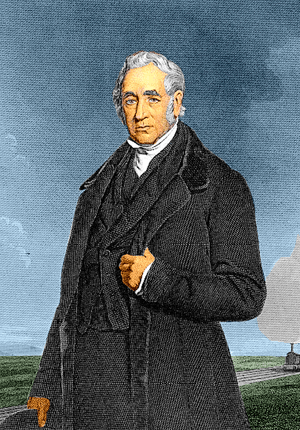
Born in Northumberland
Ashington is the birthplace of three famous footballers: Bobby and Jack Charlton, and Jackie Milburn. The international cricketer Steve Harmison was also born there.
Mickley was the birthplace of Thomas Bewick, an artist and naturalist, and Bob Stokoe, a footballer and FA Cup-winning manager.
Other notable people born in Northumberland include:
- Thomas Addison, a physician who described Addison's Disease, born in Longbenton.
- George Airy, a famous astronomer, born in Alnwick.
- Alexander Armstrong, a comedy actor and presenter, born in Rothbury.
- Lancelot 'Capability' Brown, a famous landscape designer, born in Kirkharle.
- Basil Bunting, a poet, born in Scotswood-on-Tyne.
- Eric Burdon, singer and leader of The Animals, born in Walker-on-Tyne.
- Josephine Butler, a social reformer, born in Milfield.
- Cuthbert Collingwood, a naval commander at the Battle of Trafalgar, born in Newcastle upon Tyne.
- Grace Darling, a sea-rescue heroine, born in Bamburgh.
- Pete Doherty, a musician, born in Hexham.
- Bryan Donkin, an engineer, born in Sandhoe.
- Robson Green, an actor and singer, born in Hexham.
- Charles Grey, 2nd Earl Grey, a British Prime Minister, born at Howick Hall.
- William Hewson, known as the "Father of Haematology", born in Hexham.
- Jean Heywood, an actress, born in Blyth.
- Ray Kennedy: Footballer, Liverpool F.C..
- Ross Noble, a stand-up comedian, born and raised in Cramlington.
- George Stephenson, a pioneering railway engineer, born in Wylam.
- Trevor Steven, a footballer born in Berwick-upon-Tweed.
- William Turner, an ornithologist and botanist, born in Morpeth.
- Sid Waddell, a sports commentator, born in Alnwick.
- Kevin Whately, an actor, born in Humshaugh.
- N. T. Wright, an Anglican theologian and author, born in Morpeth.
Connected to Northumberland

- William Armstrong, an engineer and inventor, built Cragside, one of the first houses powered by hydroelectric technology, near Rothbury.
- Thomas Burt, one of the first working-class members of parliament.
- Kitty Fitzgerald is an Irish writer who lives in Northumberland.
- Mark Knopfler, guitarist for Dire Straits, grew up in his mother's hometown of Blyth, Northumberland.
- Charles Algernon Parsons, inventor of the steam turbine, lived in Wylam.
- Henry 'Hotspur' Percy, a famous borders warlord.
- Alan Shearer, a famous footballer, lives in Ponteland.
- Gordon Sumner, known as Sting, was born in Newcastle upon Tyne.
- Algernon Charles Swinburne, a poet, grew up at Capheaton Hall.
- Kathryn Tickell, a modern player of the Northumbrian smallpipes.
- J. M. W. Turner, Thomas Girtin, and John Cotman all painted beautiful pictures of Northumberland.
- Jonny Wilkinson, an English rugby player, lives in rural Northumberland.
Images for kids
-
Long Crag summit
-
Railway engineer George Stephenson was born in Northumberland in 1781.
-
Algernon Charles Swinburne, the poet, was raised in Northumberland
See also
 In Spanish: Northumberland para niños
In Spanish: Northumberland para niños


